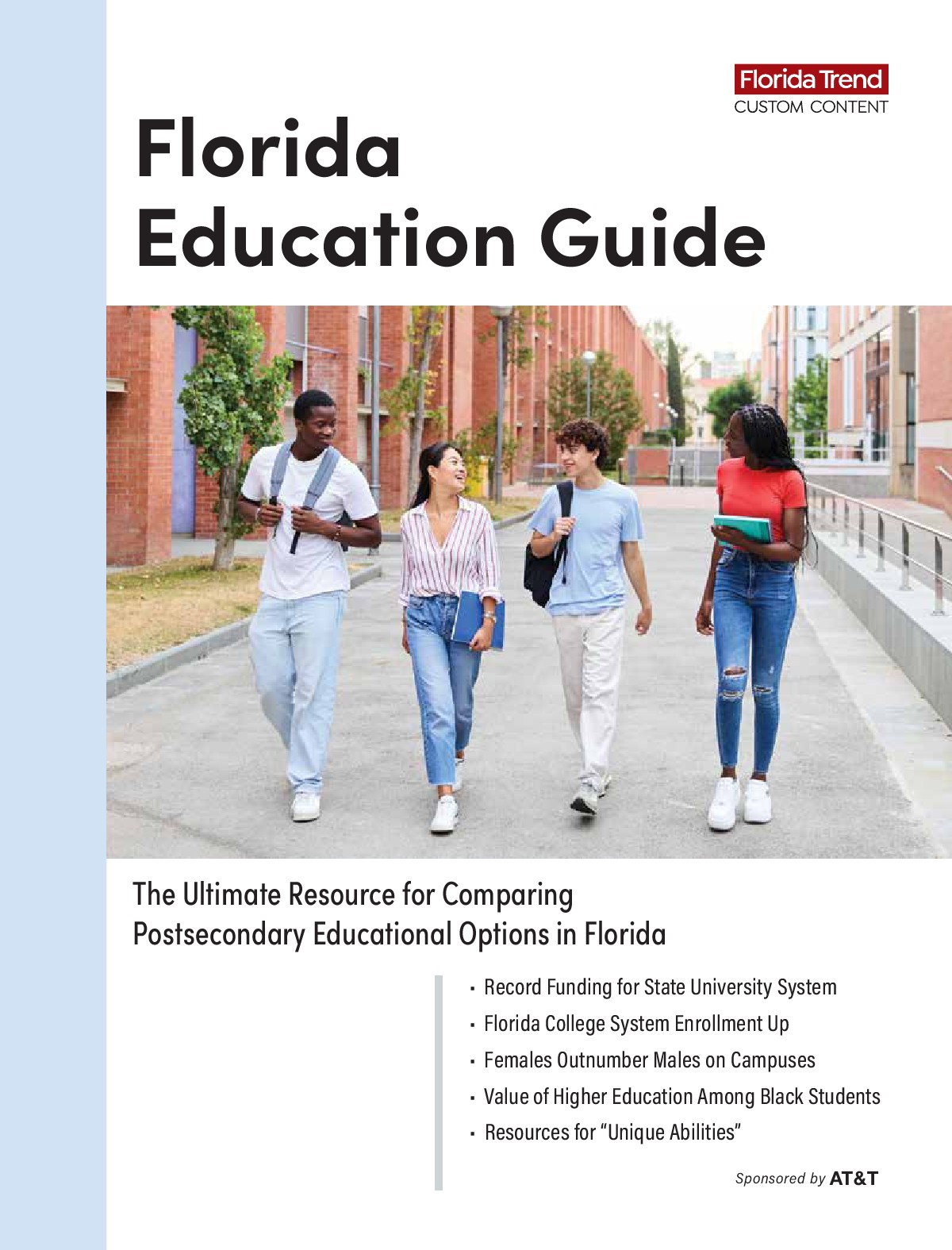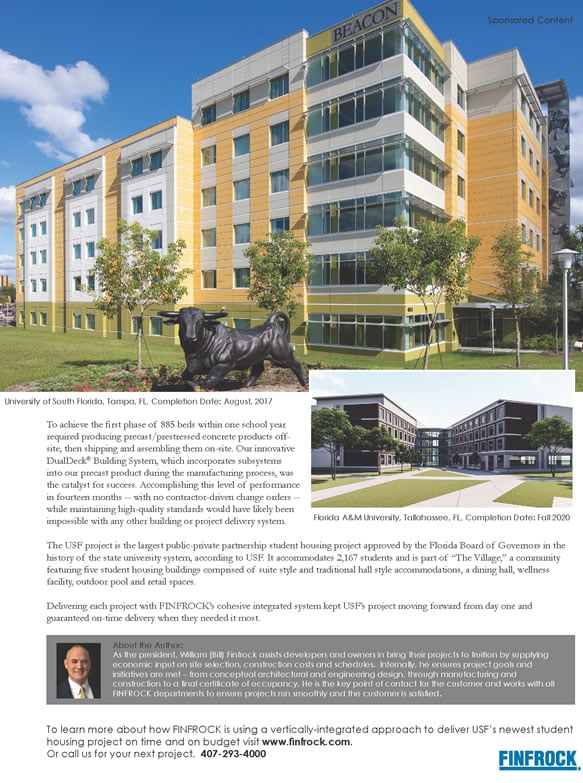
Transportation improvements, water and sewer system extensions in rural counties and access to better healthcare are big issues for leaders across the Big Bend region — and are recognized as key to meeting the No. 1 need:
 College Pipeline (Tallahassee) Beth Kirkland » Tallahassee needs “programs at the community college and university level to provide that pipeline of workers for the existing and growth sectors we’re involved with, like biotech, alternative energy, advanced manufacturing and aviation," says Economic Development Council Executive Director Beth Kirkland. [Photo: Jeffrey Camp] |
Numerous rural communities are handicapped by a lack of infrastructure to attract business. In Madison County — which lost 475 jobs when Smithfield Packing closed in late 2006 — the county spent $8 million putting water and sewer at three interchanges along Interstate 10, a project that’s already netted two travel-stop businesses. “They wouldn’t have built without water and sewage being available," says county coordinator Allen Cherry.
What Tallahassee needs most is workforce training, says Economic Development Council Executive Director Beth Kirkland — “programs at the community college and university level to provide that pipeline of workers for the existing and growth sectors we’re involved with, like biotech, alternative energy, advanced manufacturing and aviation." While Florida’s capital city feels the economic slowdown less severely than the rest of the region — Tallahassee metro area unemployment rate in January was
a low 3.3% — it hasn’t escaped the housing crunch. Leon County residential building permits issued last year, at 1,113, were the fewest since 1985.
POPULATION TREND
| See population, income and job statistics from this region. Explore |
Three Big Bend counties last year grew by percentages larger than the state’s gain: Wakulla, up 5%; Columbia, 4.1%; and Gilchrist, 2.3%. Still, because of the small size of the region’s 11 counties, overall growth added only 7,523 residents. Leon is the only county with more than 70,000 people; five counties each have fewer than 20,000 residents. While no counties lost population, only five had a growth rate exceeding their most-recent five-year average. Minuscule in-migration and the slowing economy are reflected in home sales, down 22% across the region. Home sales declined more than 30% in Columbia, Suwannee and Taylor counties.
TALLAHASSEE / LEON COUNTY
| EMPLOYMENT TREND / LEON COUNTY |
|
| Category | 1-year growth |
| Professional and business services |
+8.6% |
| Leisure and hospitality services |
+8.8 |
| Local government | +1.9 |
| State government | +0.6 |
| Manufacturing | -2.3 |
| Construction | -3.0 |
| Total job growth | +2.3% |
| Source: Florida Agency for Workforce Innovation | |
The state capital’s role in cushioning the economy could be less comforting this year as government revenue and budgets take a dive. Continuing economic diversification is paramount, leaders say. “I think we have a good start in developing a technology corridor here," says Ron Sachs, CEO of Ron Sachs Communications and this year’s Greater Tallahassee Chamber of Commerce chairman. “We are also at the front edge of the green movement. Some are talking about a green business corridor here, producing products and services to help neighborhoods to greenify themselves."
Florida State University and Tallahassee Community College will help attract advanced-technology manufacturers. TCC is creating an advanced materials program to train workers in handling the composite manufacturing materials being developed by FSU’s High Performance Materials Institute.
Randy Hanna, last year’s Chamber of Commerce chairman, was also a sparkplug for Our Region Tomorrow, a long-range economic development and environmental initiative partially funded by a $200,000 John S. and James L. Knight Foundation grant. The program spans eight adjoining Florida counties and Thomas County in Georgia. “We want to encourage governments to think across county lines ... (and) to develop a long-range vision," says Hanna, managing partner of the law firm of Bryant, Miller and Olive. “When businesses look at this area, they don’t see a difference between Tallahassee or Quincy or Monticello, but they’re interested in the region as a whole."
HAMILTON / SUWANNEE / MADISON COUNTIES
Hamilton County is breaking ground this spring on a new industrial park, where Maronda Homes will build a roof truss plant, which will eventually employ 100.
Shovel-ready industry sites are the No. 1 need in Suwannee County, followed by workforce training and other infrastructure to attract high-wage jobs.
LAFAYETTE / COLUMBIA COUNTIES
Business is growing in Lafayette, says Chamber of Commerce President Jim Hollis, citing a new bank and sandwich shop, plus his own plans to open a restaurant in Mayo in addition to his scuba dive business. “We don’t worry about the economy," says Hollis. “We just open it up and let it grow."
Columbia County is adding jobs through new distribution businesses. Target is slated to open a 150-to-200 employee distribution center this summer, and United States Cold Storage will employ 35 to 50 in its first-phase facility opening this spring. Meanwhile, the housing slowdown resulted in some 80 layoffs at two area manufactured-housing plants.
JEFFERSON / GADSDEN / WAKULLA COUNTIES
 Healthy Role (Madison) David Abercrombie » David Abercrombie, administrator of the 54-year-old Madison County Memorial Hospital, anticipates a late fall construction start for a $20-million replacement hospital; he took a lead role in persuading voters to fund it with a half-cent local option sales tax. “It will create new jobs, allow us to provide new service lines." The economic health of hospitals and residents is interdependent, says Abercrombie. [Photo: Jeffrey Camp] |
Gadsden County has conducted a water/sewer study to determine countywide infrastructure needs and make highway interchanges more viable for business, including retail outlets.
Allen Freeland, volunteer chairman of Wakulla County Chamber of Commerce’s Economic Development Council, is heading a public awareness campaign for more economic development funding “to get the county going. We don’t have any bigger businesses, and smaller ones aren’t hiring."
TAYLOR / GILCHRIST COUNTIES
Rural healthcare concerns took a critical turn in Taylor County when Doctors’ Memorial Hospital appealed to the County Commission for a $500,000 bailout plus subsequent monthly subsidies and was turned down. Steep operating losses were partly blamed on an admissions decrease.
Gilchrist is “a county in flux," says county administrator Ron McQueen. “The agriculture we’ve depended on is starting to dwindle; farmers face a number of issues ... (and) we don’t have the sewer and water or transportation corridor to attract new industries." A 12% shortfall in the county budget is expected from Amendment 1 tax changes. “We’re going to have to reduce services somewhere."













